The orange compound market was valued at USD 1,027.6 million in 2025 and is projected to reach USD 2,137.7 million by 2035, reflecting a CAGR of 7.6%. Observing the growth rate over the ten years, the market shows a steady increase from USD 1,105.7 million in 2026 to USD 1,986.7 million in 2034, culminating at the forecasted value in 2035. This steady trajectory suggests that end-user industries are consistently reinforcing demand for orange compounds in flavoring, fragrance, and chemical applications. The year-on-year increments indicate that market expansion is less prone to abrupt fluctuations, highlighting the reliability of consumption patterns and the importance of orange compounds in formulations where consistency and performance are prioritized.
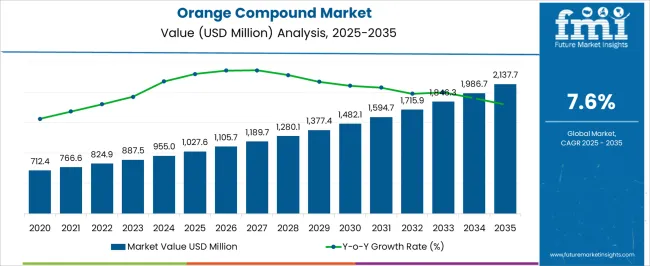
The orange compound market was valued at USD 1,027.6 million in 2025 and is projected to reach USD 2,137.7 million by 2035, growing at a CAGR of 7.6%. The growth rate volatility index over the period demonstrates controlled and predictable expansion, with annual values rising from USD 1,189.7 million in 2027 to USD 1,846.3 million in 2033. This pattern suggests that production capacities and supply chains are adapting efficiently to market demand, reducing the risk of sharp price swings or supply shortages. The steady growth emphasizes how manufacturers and end-users are relying on orange compounds to achieve uniformity in product quality, making the market a stable and strategically significant segment for chemical and flavoring industries over the next decade.
| Metric | Value |
|---|---|
| Orange Compound Market Estimated Value in (2025E) | USD 1027.6 million |
| Orange Compound Market Forecast Value in (2035 F) | USD 2137.7 million |
| Forecast CAGR (2025 to 2035) | 7.6% |
The orange compound market has been recognized as a specialized segment within several broader parent industries, each demonstrating a distinct level of integration and influence. Within the food flavors and additives market, orange compounds hold a share of approximately 6.2%, primarily due to their use in enhancing taste profiles in confectionery, bakery, and dairy products. In the beverage ingredients market, the penetration is estimated at 5.7%, as orange compounds are employed for consistent flavor delivery in juices, soft drinks, and functional beverages.
The cosmetic ingredients market records a share of around 4.3%, with applications focused on fragrance formulation, skin care products, and aromatherapy preparations. Within the fragrance compounds market, orange compounds contribute roughly 5.1%, reflecting demand for natural, citrus-based scents in personal care and household products. In the specialty chemicals market, the share stands at about 3.9%, where these compounds are utilized as intermediates in various chemical and flavor synthesis processes. Collectively, the orange compound market accounts for nearly 25.2% across these parent sectors, underlining its significance in driving flavor, fragrance, and chemical performance.
Adoption has been influenced by the demand for authentic, consistent, and high-purity compounds that enhance end-product quality. The market has been shaping competitive strategies of its parent industries, with manufacturers focusing on formulation efficiency, scalability, and regulatory compliance. Orange compounds are increasingly being positioned as essential ingredients that add value beyond taste and scent, creating differentiation and elevating consumer experiences while reinforcing the operational relevance of the parent markets in which they are embedded.
The orange compound market is advancing steadily due to increasing utilization across flavoring, fragrance, and industrial applications. Driven by consumer preference for natural and citrus-derived ingredients, the market has seen consistent demand from food and beverage manufacturers, particularly in carbonated drinks, bakery, and confectionery categories. The rise in clean-label formulations and demand for plant-based aromas has further cemented orange compounds as desirable additives.
Additionally, the global shift toward sustainable sourcing and biodegradable solvents has enhanced their industrial relevance. Regulatory approval across key regions and GRAS (Generally Recognized as Safe) status for several compounds have further eased their incorporation into consumable products.
While synthetic alternatives still exist, orange compounds offer functional and aromatic benefits that align with evolving consumer expectations. Looking ahead, increased integration into nutraceuticals, green solvents, and eco-friendly cleaners is projected to sustain momentum, reinforcing the market’s position as a pivotal node in both food-grade and non-food-grade value chains globally.
The orange compound market is segmented by product, application, and geographic regions. By product, orange compound market is divided into D-Limonene, α-Pinene, β-Pinene, Linalool, Decanal, Myrcene, Nootkatone, Octanal, Nonanal, Valencene, Perillaldehyde, and Sabinene. In terms of application, orange compound market is classified into Food & Beverage, Personal Care & Cosmetics, and Others. Regionally, the orange compound industry is classified into North America, Latin America, Western Europe, Eastern Europe, Balkan & Baltic Countries, Russia & Belarus, Central Asia, East Asia, South Asia & Pacific, and the Middle East & Africa.
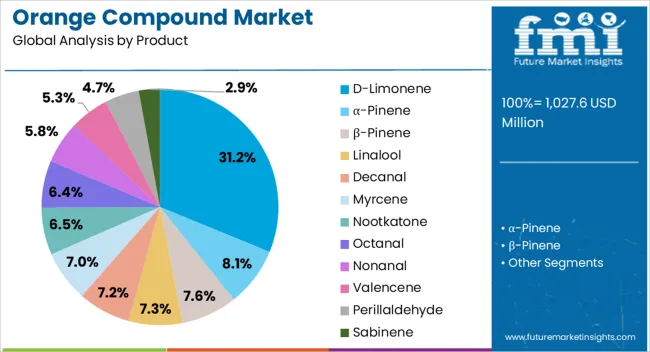
The D-limonene segment leads the orange compound market by product, holding a 31.2% share, owing to its widespread adoption across multiple verticals. This compound, extracted from citrus peels, has gained significant traction due to its multipurpose characteristics including flavoring, fragrance, and solvent capabilities. Growth in the segment has been largely supported by rising consumer inclination toward natural ingredients in food and personal care products, along with the industrial sector’s demand for green chemicals.
In addition to flavor and aroma enhancement, D-limonene is utilized in degreasers, adhesives, and cleaning agents, thereby extending its market reach. Regulatory approvals across key markets have further catalyzed adoption, particularly in applications where low toxicity and biodegradability are critical.
The segment’s momentum is also reinforced by increased citrus fruit processing, which ensures consistent raw material availability. As demand rises for natural solvents and eco-certified flavoring agents, D-limonene is expected to maintain its leading share through its functional adaptability and environmental appeal.
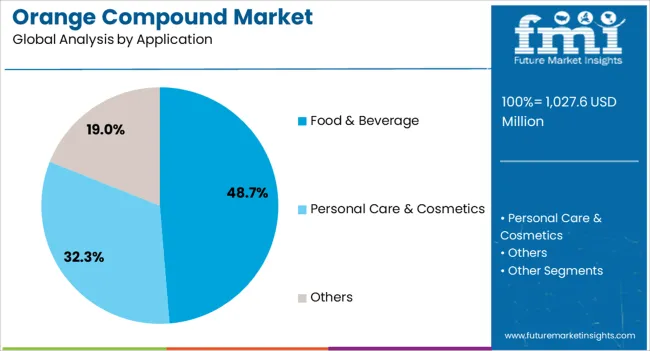
The food & beverage segment remains the dominant application area in the orange compound market, accounting for 48.7% of total usage. This leadership position is driven by escalating demand for natural flavor enhancers, particularly those that impart citrus notes, in beverages, baked goods, confectionery, and dairy products. The rising popularity of functional and fortified beverages has further spurred the use of orange compounds as both flavoring agents and carriers for bioactive components.
In this segment, manufacturers prefer citrus-based extracts due to their recognized safety profiles, compatibility with clean-label norms, and ability to mask undesirable tastes in health formulations. Additionally, the shift away from artificial additives has amplified demand for citrus-derived compounds, aligning with global reformulation trends.
Regulatory backing and expanding product portfolios have supported their wider inclusion in both mainstream and niche product categories. As food producers continue to prioritize natural sensory attributes and label transparency, the food & beverage segment is expected to sustain its leadership within the orange compound market landscape.
The orange compound market has been influenced by its widespread use in flavoring, fragrance, and food additive applications. Demand has been driven by growing consumption in beverages, confectionery, and processed foods, while opportunities have emerged in natural and specialty orange derivatives catering to premium products. Trends are being observed in clean-label formulations, functional blends, and versatile applications across industries, whereas challenges persist in raw material price volatility, regulatory compliance, and supply chain constraints. Overall, the market is expected to grow steadily as manufacturers seek distinctive flavor and fragrance solutions.
The demand for orange compounds has been strongly influenced by their extensive use in beverages, confectionery, and processed food products. Beverage manufacturers and snack producers have been observed increasingly relying on orange compounds to deliver consistent taste, aroma, and consumer-preferred sensory profiles. In opinion, this demand has been reinforced by the growing inclination of consumers toward flavored drinks, fruit-based snacks, and ready-to-eat processed foods where natural or synthetic orange derivatives are preferred. Flavor houses and food ingredient suppliers have been prioritizing formulations that provide authentic orange notes, long shelf life, and compatibility with various food matrices. The demand trajectory has also been shaped by seasonal consumption patterns, regional preferences, and product innovation in functional foods and beverages. Overall, the reliance on orange compounds is being viewed as essential for maintaining product consistency, enhancing taste appeal, and meeting evolving consumer expectations in competitive food and beverage markets.
Opportunities in the orange compound market have been largely defined by the growing demand for natural extracts, clean-label ingredients, and specialty derivatives for premium products. Flavor and fragrance manufacturers have been observed leveraging high-quality orange compounds to create differentiated beverages, confectionery, and cosmetic offerings. In opinion, emerging markets present significant opportunities as disposable incomes rise and demand for exotic or enhanced flavor profiles increases. Functional blends combining orange compounds with complementary citrus or botanical ingredients are being explored to add perceived health and sensory benefits. Opportunities have also been created by expanding applications in oral care, personal care, and aromatherapy products, where natural orange notes are valued. These opportunities are further reinforced by collaborations between ingredient suppliers and end-use product manufacturers to create tailored solutions. Overall, market growth is expected to be supported by premiumization trends, evolving taste preferences, and demand for versatile, high-quality orange compounds across multiple industries.
The orange compound market has been shaped by trends in clean-label ingredients, functional formulations, and multi-industry applications. Increasing consumer awareness has prompted food and beverage manufacturers to prioritize natural or minimally processed orange compounds in their recipes. In opinion, the market is also witnessing trends in functional blends where orange compounds are combined with complementary nutrients or flavors to enhance sensory appeal and product positioning. Flavor houses and cosmetic manufacturers have been adapting to these trends by providing flexible formulations compatible with various matrices, including beverages, confectionery, desserts, and personal care products. Additionally, innovations in microencapsulation and carrier technologies have facilitated the controlled release of orange aroma and taste, creating opportunities for premium applications. Overall, these trends are expected to define product development strategies, strengthen market positioning, and shape competitive dynamics, with companies focusing on authenticity, versatility, and multi-sensory appeal.
The orange compound market has faced persistent challenges related to raw material price volatility, supply chain limitations, and stringent regulatory requirements. The cost of orange oils, extracts, and derivatives is influenced by climatic conditions, crop yields, and regional production patterns, which can disrupt consistent supply. In opinion, regulatory frameworks governing flavor and fragrance compounds vary across countries, creating compliance challenges for manufacturers targeting global markets. Quality control, ingredient labeling, and safety testing have also emerged as critical barriers, particularly for natural or functional formulations. Supply chain dependencies, including transportation and storage of sensitive compounds, have occasionally constrained market expansion. Addressing these challenges requires strategic sourcing, adherence to international quality standards, and long-term supplier relationships. Overcoming these barriers is essential for ensuring reliable supply, maintaining product integrity, and supporting sustained growth in the orange compound market.
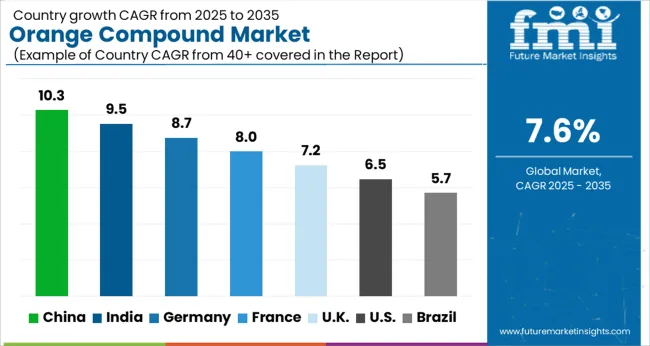
| Country | CAGR |
|---|---|
| China | 10.3% |
| India | 9.5% |
| Germany | 8.7% |
| France | 8.0% |
| UK | 7.2% |
| USA | 6.5% |
| Brazil | 5.7% |
The global orange compound market is projected to grow at a CAGR of 7.6% from 2025 to 2035. China leads with 10.3% growth, followed by India at 9.5%, and Germany at 8.7%. The United Kingdom records 7.2%, while the United States shows 6.5% growth. Expansion is being driven by increasing demand for natural and processed flavors, confectionery, beverages, and bakery applications. Emerging markets such as China and India are witnessing faster growth due to rising consumption of processed foods, growing beverage industries, and expanding confectionery manufacturing, while developed markets focus on product innovation, premium flavor integration, and health-oriented applications in food and beverages. This report includes insights on 40+ countries; the top markets are shown here for reference.
The orange compound market in China is growing at a CAGR of 10.3%, supported by increasing demand from the beverage, confectionery, and bakery sectors. Manufacturers are adopting high-quality orange compounds to meet consumer preferences for natural flavors and consistent taste profiles. Growth is reinforced by the expanding processed food market and rising domestic consumption of flavored products. Investments in food processing infrastructure and supply chain improvements are enabling manufacturers to scale production and ensure consistent quality. Urbanization and changing dietary patterns further accelerate the adoption of orange compounds in a variety of applications.
The orange compound market in India is advancing at a CAGR of 9.5%, fueled by growth in processed foods, beverages, and confectionery production. Manufacturers are adopting orange compounds to enhance flavor profiles, maintain consistency, and meet rising consumer expectations. Market growth is supported by increasing domestic consumption, expanding retail chains, and food industry modernization initiatives. Investments in processing technology and distribution networks facilitate broader market reach. Adoption is also being driven by the rise of ready-to-eat and packaged food products where orange compounds are widely used.
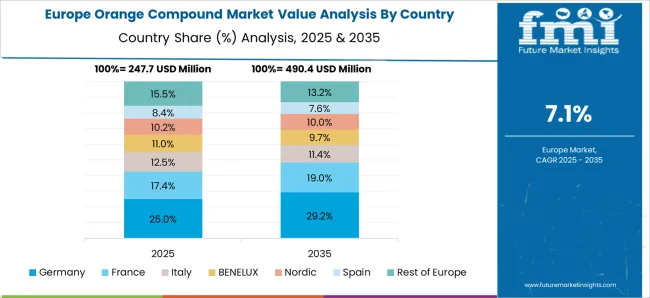
The orange compound market in Germany is projected to grow at a CAGR of 8.7%, driven by demand from premium confectionery, beverage, and bakery applications. German manufacturers focus on high-quality, natural flavor compounds to meet strict food safety and taste standards. Market expansion is reinforced by consumer preference for authentic flavors and innovative product formulations. Research and development initiatives support the creation of new flavor variants, while industrial-scale production ensures consistent supply for domestic and export markets. Demand is particularly strong in processed beverages and bakery sectors where flavor consistency is critical.
The orange compound market in the United Kingdom is expanding at a CAGR of 7.2%, supported by growth in confectionery, beverages, and baked goods industries. Manufacturers are integrating orange compounds to enhance taste, color, and aroma in products. Market growth is further reinforced by consumer demand for flavored snacks, ready-to-drink beverages, and innovative bakery items. Adoption is being facilitated by strong industrial capabilities and established distribution channels. Focus on premiumization and product differentiation also encourages manufacturers to utilize high-quality orange compounds in diverse applications.
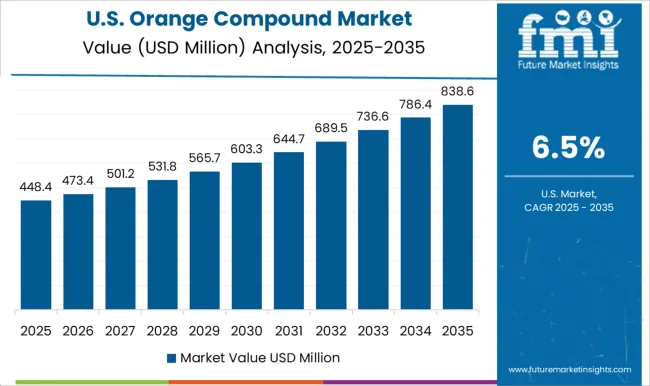
The orange compound market in the United States is growing at a CAGR of 6.5%, driven by demand in beverages, confectionery, and bakery applications. USA manufacturers are emphasizing natural and consistent flavor solutions to meet consumer expectations and regulatory standards. Growth is supported by innovation in flavor blends, product diversification, and rising consumption of processed foods. Market adoption is also influenced by premium product launches, beverage flavoring, and health-oriented food segments. While growth is moderate compared to emerging markets, steady demand ensures continued market expansion.
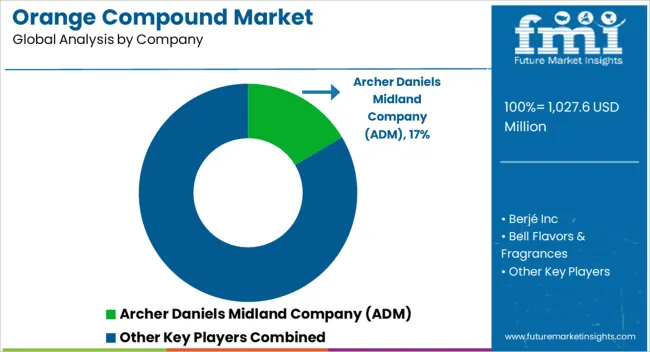
The orange compound market is being driven by a combination of global agribusiness giants, flavor specialists, and essential oil producers. Archer Daniels Midland (ADM) and Citrosuco are being positioned through large-scale citrus processing, consistent quality, and integrated supply chains that ensure year-round availability. Their strategy is being focused on high-purity extracts, regulatory compliance, and multi-industry applications spanning beverages, confectionery, and personal care. Firmenich SA, Bell Flavors & Fragrances, and MCI Miritz (Symrise) are being recognized for tailored solutions, blending innovation with precise flavor profiling to meet evolving consumer tastes. Berjé Inc, Bontoux S.A., and Vigon International are being directed toward niche formulations, emphasizing concentrated oils, aroma stability, and clean-label compliance.
Citrus and Allied Essences Ltd. and Lionel Hitchen (Essential Oils) Ltd. are being noted for artisanal and small-batch extraction methods, catering to specialty products and premium segments. Competition is being defined by purity, flavor consistency, and application versatility, with leadership shaped by supply reliability, traceable sourcing, and demonstrated expertise in citrus chemistry. Product brochures are being designed as compact, persuasive sales tools. ADM and Citrosuco brochures are being structured around supply chain transparency, extraction techniques, and broad application suitability, with visuals highlighting product color, clarity, and concentration.
Firmenich, Bell Flavors & Fragrances, and Symrise brochures emphasize aroma profiles, flavor stability, and regulatory compliance, using performance charts and sensory maps to communicate value. Berjé, Bontoux, and Vigon brochures are being tailored to highlight concentration levels, purity certifications, and formulation flexibility. Citrus and Allied Essences and Lionel Hitchin brochures focus on artisanal quality, small-batch authenticity, and traceable sourcing. Each brochure is being developed to act as a standalone reference, blending visuals, concise specifications, and application highlights.
| Item | Value |
|---|---|
| Quantitative Units | USD 1027.6 Million |
| Product | D-Limonene, α-Pinene, β-Pinene, Linalool, Decanal, Myrcene, Nootkatone, Octanal, Nonanal, Valencene, Perillaldehyde, and Sabinene |
| Application | Food & Beverage, Personal Care & Cosmetics, and Others |
| Regions Covered | North America, Europe, Asia-Pacific, Latin America, Middle East & Africa |
| Country Covered | United States, Canada, Germany, France, United Kingdom, China, Japan, India, Brazil, South Africa |
| Key Companies Profiled | Archer Daniels Midland Company (ADM), Berjé Inc, Bell Flavors & Fragrances, Bontoux S.A., Citrosuco, Citrus and Allied Essences Ltd., Firmenich SA, Lionel Hitchen (Essential Oils) Ltd., MCI Miritz, Symrise, and Vigon International Inc. |
| Additional Attributes | Dollar sales by product type (liquid, powder, paste) and application (beverages, confectionery, bakery, dairy) are key metrics. Trends include rising demand for natural and flavorful ingredients, growth in ready-to-drink and processed foods, and increasing adoption in flavor formulations. Regional adoption, consumer preferences, and technological advancements are driving market growth. |
The global orange compound market is estimated to be valued at USD 1,027.6 million in 2025.
The market size for the orange compound market is projected to reach USD 2,137.7 million by 2035.
The orange compound market is expected to grow at a 7.6% CAGR between 2025 and 2035.
The key product types in orange compound market are d-limonene, α-pinene, β-pinene, linalool, decanal, myrcene, nootkatone, octanal, nonanal, valencene, perillaldehyde and sabinene.
In terms of application, food & beverage segment to command 48.7% share in the orange compound market in 2025.






Our Research Products

The "Full Research Suite" delivers actionable market intel, deep dives on markets or technologies, so clients act faster, cut risk, and unlock growth.

The Leaderboard benchmarks and ranks top vendors, classifying them as Established Leaders, Leading Challengers, or Disruptors & Challengers.

Locates where complements amplify value and substitutes erode it, forecasting net impact by horizon

We deliver granular, decision-grade intel: market sizing, 5-year forecasts, pricing, adoption, usage, revenue, and operational KPIs—plus competitor tracking, regulation, and value chains—across 60 countries broadly.

Spot the shifts before they hit your P&L. We track inflection points, adoption curves, pricing moves, and ecosystem plays to show where demand is heading, why it is changing, and what to do next across high-growth markets and disruptive tech

Real-time reads of user behavior. We track shifting priorities, perceptions of today’s and next-gen services, and provider experience, then pace how fast tech moves from trial to adoption, blending buyer, consumer, and channel inputs with social signals (#WhySwitch, #UX).

Partner with our analyst team to build a custom report designed around your business priorities. From analysing market trends to assessing competitors or crafting bespoke datasets, we tailor insights to your needs.
Supplier Intelligence
Discovery & Profiling
Capacity & Footprint
Performance & Risk
Compliance & Governance
Commercial Readiness
Who Supplies Whom
Scorecards & Shortlists
Playbooks & Docs
Category Intelligence
Definition & Scope
Demand & Use Cases
Cost Drivers
Market Structure
Supply Chain Map
Trade & Policy
Operating Norms
Deliverables
Buyer Intelligence
Account Basics
Spend & Scope
Procurement Model
Vendor Requirements
Terms & Policies
Entry Strategy
Pain Points & Triggers
Outputs
Pricing Analysis
Benchmarks
Trends
Should-Cost
Indexation
Landed Cost
Commercial Terms
Deliverables
Brand Analysis
Positioning & Value Prop
Share & Presence
Customer Evidence
Go-to-Market
Digital & Reputation
Compliance & Trust
KPIs & Gaps
Outputs
Full Research Suite comprises of:
Market outlook & trends analysis
Interviews & case studies
Strategic recommendations
Vendor profiles & capabilities analysis
5-year forecasts
8 regions and 60+ country-level data splits
Market segment data splits
12 months of continuous data updates
DELIVERED AS:
PDF EXCEL ONLINE
Orange Terpenes Market Size and Share Forecast Outlook 2025 to 2035
Market Share Insights for Orange Extract Suppliers
Competitive Overview of Orange Juice Market Share
Acid Orange Market
Unconcentrated Orange Juice Market Analysis - Size, Share, & Forecast Outlook 2025 to 2035
Compound Coatings Market Analysis - Size, Share, and Forecast Outlook 2025 to 2035
Compound Semiconductor Hall Elements Market Size and Share Forecast Outlook 2025 to 2035
Compounds Market Size and Share Forecast Outlook 2025 to 2035
Compound Chocolate Market Analysis - Size, Share, and Forecast Outlook 2025 to 2035
Compound Semiconductor Materials Market Growth - Trends & Forecast 2025 to 2035
Compound Horse Feedstuff Market Analysis by Feed Type, Horse Activity, and Ingredient Composition Through 2035
Compound Feed Market Analysis by Ingredients, Form, Livestock and Region through 2035
Compounded Topical Drugs Market Analysis – Size, Share & Forecast 2024-2034
Compound Semiconductor Market Analysis – Growth & Forecast 2024-2034
Compounding Systems Market
Compounded Bioidentical Hormone Therapy Market
Wire Compounds and Cable Compounds Market Growth - Trends & Forecast 2025 to 2035
Joint Compound Market Size and Share Forecast Outlook 2025 to 2035
Lemon Compound Market Size and Share Forecast Outlook 2025 to 2035
Flavor Compounds Market Size and Share Forecast Outlook 2025 to 2035

Thank you!
You will receive an email from our Business Development Manager. Please be sure to check your SPAM/JUNK folder too.
Chat With
MaRIA